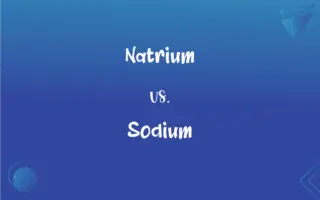Surface Tension vs. Capillary Action: What's the Difference?
Edited by Janet White || By Harlon Moss || Published on January 9, 2024
Surface tension is the elastic tendency of liquids due to intermolecular forces at the surface, whereas capillary action is the ability of a liquid to flow in narrow spaces without external forces like gravity.

Key Differences
Surface tension is a physical phenomenon where the surface of a liquid, in contact with gas, acts like a thin elastic sheet due to cohesive forces between liquid molecules. In contrast, capillary action occurs when a liquid moves up a narrow tube or porous material due to adhesive forces between the liquid and the material's surface.
The key factor in surface tension is the imbalance of intermolecular forces experienced by molecules on the surface of a liquid. Conversely, capillary action results from the combination of surface tension and the adhesive forces between the liquid and the capillary wall.
Surface tension is often observed when small objects float on a liquid surface without sinking, a result of the liquid's resistance to external force. Capillary action, however, is evident when liquids defy gravity, as seen when water travels up a plant's roots and stems.
Measuring surface tension involves assessing the force needed to break the surface of a liquid. On the other hand, capillary action is measured by the height to which a liquid can climb against gravity in a narrow space.
Applications of surface tension include the formation of bubbles and droplets, whereas capillary action is critical in processes like ink flow in pens and water movement in plants.
ADVERTISEMENT
Comparison Chart
Definition
Elasticity of liquid surfaces
Liquid's movement in narrow spaces
Primary Forces
Cohesive forces among liquid molecules
Adhesive forces between liquid and surface
Observable Effects
Formation of droplets, bubbles
Rise or fall of liquid in tubes or porous media
Measurement
Force required to break liquid surface
Height liquid climbs against gravity
Examples of Applications
Soap bubbles, water striders
Plant water transport, paper towels absorbing
ADVERTISEMENT
Surface Tension and Capillary Action Definitions
Surface Tension
Energy required to increase the surface area of a liquid.
Soap reduces the surface tension of water, aiding cleaning.
Capillary Action
Liquid's ability to flow against external forces.
Paper towels absorb spills by capillary action.
Surface Tension
Balance of attractive forces at a liquid-gas interface.
Raindrops form spheres due to surface tension.
Capillary Action
Movement of liquid within narrow spaces against gravity.
Water moves up a thin tube due to capillary action.
Surface Tension
Cohesive force at a liquid's surface.
Water droplets form beads on a waxed car due to surface tension.
Capillary Action
Interaction of cohesive and adhesive forces in liquids.
Capillary action is why a sponge absorbs water.
Surface Tension
Measure of the elasticity of a liquid surface.
Surface tension allows small insects to walk on water.
Capillary Action
Liquid flow in porous materials or thin tubes.
Ink travels in a pen's nib through capillary action.
Surface Tension
Force acting perpendicularly to a liquid surface.
Surface tension keeps a paper clip floating on water.
Capillary Action
Rise or fall of a liquid in a small passage.
Plant roots use capillary action to draw water from the soil.
FAQs
Can surface tension be reduced?
Yes, surface tension can be reduced by substances like detergents.
Is surface tension the same for all liquids?
No, surface tension varies between liquids due to differences in molecular structure.
What factors affect capillary action?
Capillary action is influenced by the liquid's surface tension and the adhesive forces between the liquid and the tube or material.
How does capillary action benefit plants?
Capillary action allows plants to transport water from roots to leaves.
What causes surface tension?
Surface tension is caused by cohesive forces between liquid molecules at the surface.
What is a practical application of surface tension?
A practical application is the use of droppers in medicine, relying on surface tension to form droplets.
What role does surface tension play in nature?
Surface tension is crucial for phenomena like water striders walking on water.
Can capillary action occur in all liquids?
Capillary action can occur in most liquids, but its effectiveness varies based on liquid properties and the material of the capillary.
How do detergents affect capillary action?
Detergents can reduce the surface tension, potentially altering capillary action.
How does surface tension affect water droplets?
Surface tension makes water droplets form spherical shapes to minimize surface area.
What is capillary action?
Capillary action is the ability of a liquid to flow in narrow spaces without external forces.
Is capillary action a form of surface tension?
Capillary action is related to but distinct from surface tension, involving both cohesive and adhesive forces.
Can surface tension support weight?
Yes, surface tension can support small objects, like paper clips, on the water surface.
Can surface tension purify water?
Surface tension plays a role in water purification, affecting how contaminants interact with water.
Is capillary action always upwards?
Capillary action can be upwards or downwards, depending on the orientation of the capillary and gravity.
How does gravity affect capillary action?
Gravity can counteract capillary action, influencing the height to which a liquid can rise.
What is an example of capillary action in everyday life?
An example is the wicking of liquid in a towel or cloth.
Does temperature affect surface tension?
Yes, surface tension typically decreases with increasing temperature.
Do all materials show capillary action?
Capillary action varies with materials, being more pronounced in porous or fibrous materials.
How do you measure surface tension?
Surface tension can be measured using methods like the Du Noüy ring method.
About Author
Written by
Harlon MossHarlon is a seasoned quality moderator and accomplished content writer for Difference Wiki. An alumnus of the prestigious University of California, he earned his degree in Computer Science. Leveraging his academic background, Harlon brings a meticulous and informed perspective to his work, ensuring content accuracy and excellence.
Edited by
Janet WhiteJanet White has been an esteemed writer and blogger for Difference Wiki. Holding a Master's degree in Science and Medical Journalism from the prestigious Boston University, she has consistently demonstrated her expertise and passion for her field. When she's not immersed in her work, Janet relishes her time exercising, delving into a good book, and cherishing moments with friends and family.






































































